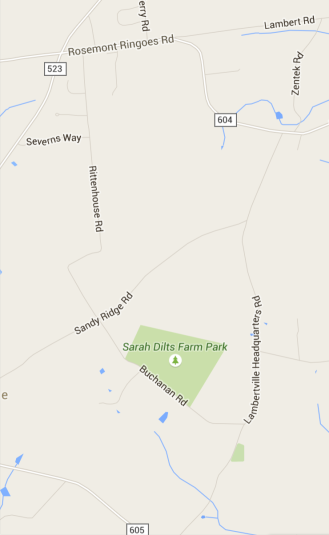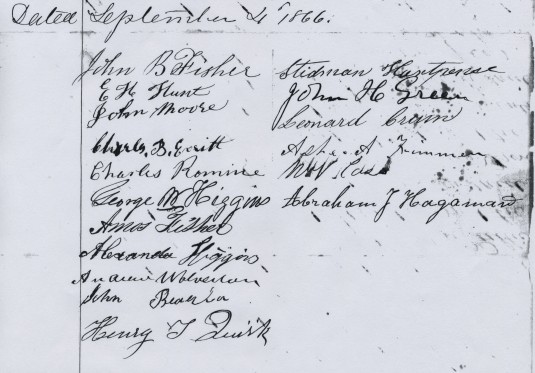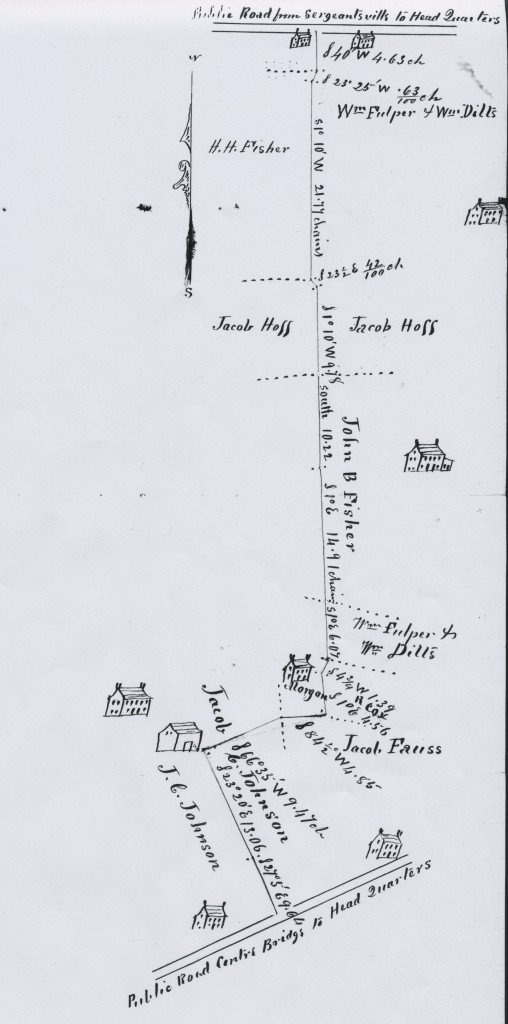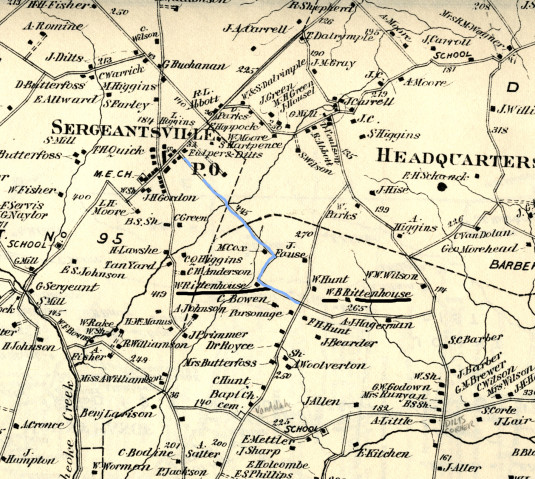
There is an odd sort of road in Delaware Township, running south from Sergeantsville, that I have often wondered about. It is called Rittenhouse Road, and for much of its length, it runs straight as an arrow, then suddenly does a zigzag before ending at Sandy Ridge Road.
Quite often the very straight roads in Hunterdon County were created as a result of the early, large proprietary tracts that forced roads to run along their borders. But that is not the case here. This road ran through the middle of Daniel Robins’ 700+ acres, surveyed in 1722.
And then there is the odd business of the road having two names. Rittenhouse Road ends at the Sandy Ridge Road, and continues on as Buchanan Road. In the 1890s, the two roads were together known as “the road from Sergeantsville to Dilts Corner.” In the Google map above, Dilts Corner is just off the bottom edge, where Route 605 and Lambertville-Headquarters Road intersect. Buchanan Road does not take you to that point, but gets pretty close.
Back in in the 18th century, however, Rittenhouse Road had a different identity.
Tinker’s Lane
In 1787, it was a lane that ran along the property line of Amos Thatcher and Benjamin Tyson. Tyson’s land was sold at a sheriff’s sale that year, and purchased by Gabriel Covenhoven. The deed description said that Tyson’s land bordered Amos Thatcher and “Tinker’s Lane,” and the metes and bounds show that Tinker’s Lane was actually Rittenhouse Road.1
Amos Thatcher bought part of his farm of 214 acres from two of the sons of Daniel Robins, Job and Elisha Robins in the 1730s. It appears from a later deed, that the part of his land that ran along Rittenhouse Road was purchased from Isaac Larew in 1760.2 But there is no deed recorded to say when or from whom Isaac Larew got that property.
In 1793, Gabriel Covenhoven sold his 119 acres to Charles and Sarah Sergeant and gave them a mortgage for £300. Once again, the western boundary was a straight line that ended in a stone in “Tinker’s Lane.”3
Exactly who that Tinker was, I cannot say. He was probably not a landowner, but one of those people who managed to keep themselves out of the old record books.
The Public Road
It was not until September 4, 1866 that John B. Fisher presented an application to the county freeholders to have the lane surveyed and recorded as a public road. The petition was signed by Fisher, along with E. H. Hunt, John Moore, Charles B. Everitt, Charles Romine, George W. Higgins, Amos Fisher, Alexander Higgins, Andrew Wolverton, John Reading? Henry T. Quirk, Stidman Hartpense, John H. Green, Leonard Crum, Asher A. Trimmer, N. W. Case, and Abraham J. Hagaman.4

The report of the Freeholders in charge of the road carefully described the beginning and end points:
“Beginning at an iron spike on the south side of the road leading from Sergeantsville to Head Quarters which said spike is distant thirty five feet three inches from a Black Cherry tree standing on lands of Dr. Isaac S. Cramer on the north side of said road, and distant twenty feet seven inches from the corner post of James W. Hawk’s lot, and running thence a southerly direction to an iron spike in the Public Road leading form Centre Bridge to Head Quarters which said last mentioned spike is distant twenty one feet eight inches from a notch cut in a rail in the fence between Wilson Hunt and Jacob C. Johnson’s land, on the east side of said road, and distant seventeen feet eight inches from the corner post between Jacob C. Johnson and Charles C. Bowne on the west side of said road, and there ending . . .”
It should also be observed that petitions for new roads and the surveys made for them never named the roads. It was common practice in those days to refer to a road as what I’ll call a from-and-to road, as in the road from Sergeantsville to Dilts Corner, or, as on the survey, the road from Sergeantsville to Headquarters for Route 604 and the road from Headquarters to Centre Bridge (Stockton) for Lambertville-Headquarters Road.
This end point was at the intersection with Sandy Ridge Road. The petition only concerned itself with Rittenhouse Road. It did not extend further south. This is because Buchanan Road had previously been surveyed, in 1857.5
When it comes to surveyors’ maps, the one on file for Rittenhouse Road is one of the best I’ve ever seen, due to its careful depiction of the houses and landowners along the route. (The dotted lines appear to be lot lines, but in fact, they indicate changes in the road’s direction.)

As you can see from the number of landowners along the road, people must have been finding a way to go places long before the road was made public. When your means of locomotion is your feet or a horse, you are not limited to a paved way—you can walk or ride over fields or through woods without much hindrance. There was, of course, the matter of respecting people’s property rights, which is why Rittenhouse Road was probably an established path or lane long before 1866. In 1860, Jacob C. Johnson bought a farm along this lane, and at the same time, bought an access lane, which later became part of the road.
The Bordering Land Owners
H. H. Fisher
Henry H. Fisher (1801-1881) was the uncle of the petitioner, John B. Fisher. In 1832, Henry H. Fisher, in partnership with Amos Hoagland, purchased the property bordering Rittenhouse Road from Jonas Thatcher and wife Anna.6 It amounted to 62+ acres, and included all of southeast Sergeantsville. But that deed of 1832 did not include the house shown on the map at the northwest corner of Rittenhouse Road; at that time it was owned by Isaac Case, who bought a half-acre lot from Jonas Thatcher in 1823, and a lane next to it in 1830.7
A great deal more can be said about Henry H. Fisher. I’m saving him for a post of his own. But I have written about him before, in The Sergeantsville Inn.
Wm. Fulper and Wm. Dilts
The house on the northeast corner eventually became the home of Charles Jurgensen, who wrote about “old ways” in an article titled “Catalpa Farm,” published on the website of the Hunterdon Co. Historical Society.
I believe that William H. Fulper (c.1837-1887) was the nephew of William M. Dilts. (Actually, Fulper’s aunt was Wm. Dilts’ wife Elizabeth Fulper.) Wm. H. Fulper was a major figure in Flemington’s business community, and ran an important general store there for many years.
In 1913, the property shown on the road survey map was sold to Christian Jurgensen by James B. Fulper, who was Wm. H. Fulper’s younger brother.
Rev. Jacob Hoff
This was Rev. Jacob Hoff, born in 1806, and living in Tewksbury in 1850, with his wife Sarah and their eight children. By 1860 he had moved to Delaware Township, where he pastored at the Sergeantsville Methodist Church. The Philadelphia map of 1860 shows him living not on Rittenhouse Road but on Route 523, on a property that extended from that road to Rittenhouse Road. He bought that farm in 1860 from Peter Green.8
In 1868, he sold his farm to Charles Green. I do not know what happened to him after that, but he died on October 3, 1874 and was buried in the Rosemont Cemetery. His wife Sarah Hoffman (1812-1901) was buried next to him.
John B. Fisher
Fisher was the one who spear-headed the petition drive to get a public road here. I have a lot of information on him because he owned the house that I have been researching. So I will save that information for a future post.
Rev. Morgan R. Cox
Morgan Cox was born in 1798 to Hon. James Cox and Ann Borden Potts of Upper Freehold, Monmouth County. He became a Baptist minister and moved to Amwell Township and in 1822 married Mary Bray Rittenhouse, daughter of Jonathan Rittenhouse (1770-1846) and Delilah Bray (1777-1857). In 1825, he was licensed to preach by the Kingwood Baptist congregation (which included the church in Locktown). Between that time and 1860 I cannot say where he was living, but that year, he purchased from John G. Fisher (father of John B. Fisher) five small lots (totaling about 23 acres) on what became Rittenhouse Road.9 The Philadelphia map of 1860 shows him there. He was still there when the Beers Atlas of 1873 was published.
Rev. Cox died in Delaware Township on January 9, 1881. His wife Mary Bray Rittenhouse Cox died on September 13, 1880. They were buried in the Sandy Ridge Cemetery.
Jacob Fauss
According to his 1888 obituary, Jacob Fauss had lived at his home near Sandy Ridge for fifty years. So he must have bought the property in the mid-1830s. But he would have been too young then, since he was born on June 19, 1813. I suspect the farm had belonged to his father John Fauss, who purchased a lot of 50 acres in 1814 that bordered property owners in the Sandy Ridge vicinity.
Jacob Fauss married Elizabeth Wolverton (1817-1892), daughter of Richard Wolverton and Sarah Case, on October 13, 1837. He was listed as a householder in the 1840 census for Delaware Township, and in 1850 he was a 36-year-old farmer. He and wife Elizabeth had four daughters at that time.
I do not know if there is anything more to be said of him other than that he farmed all his life and died where he lived, age 74, on March 17, 1888.
Jacob C. Johnson
Jacob C. Johnson was another Delaware Township farmer. He was born about 1823, and died age 67 in 1890. His wife was Catherine Moore (1832-1910), daughter of Asa Moore and Mary White. It appears that they did not have any children.
I have not succeeded in identifying his parents. In the 1850 census, he was 25 years old, living in the household of the Sergeantsville butcher, West Brewer. He was working as a farmer with property worth $3,400.
I expect him to be a grandson of Martin Johnson and Anna Trout, just as Anna Johnson, wife of Henry H. Fisher, was. But as yet I have not found the connection.
Johnson was an investor in real estate. From 1849 to 1869 he bought 13 different properties. It would take some research to figure out which of them was his home. The purchase that is most relevant here is the one he made in 1860 in which he bought 69+ acres from George W. Sharp.10 George Sharp showed up on the Cornell Map of 1851 living close to what became Rittenhouse Road.11 I will have more to say about that property.
Road Damages
The road file contains papers related to damage claims. I do not know if this is routine, but the freeholders concerned with laying out the road designated someone to assess damage to properties along the route. This is the list that was submitted:
Wm. Fulper & Wm. Dilts (awarded $200), Henry H. Fisher $50, Jacob Hoff $127, Morgan R. Cox $80, Jacob Fauss $20, and Jacob C. Johnson $250.
Interestingly, John B. Fisher, the person who initiated the road petition, was not awarded any damages. Perhaps he was the only one satisfied with the new road. Some of the other owners were not satisfied with their damages. William Fulper and William Dilts complained and had their damages adjusted to $297.57.
A New Name: Rittenhouse Road
Naming roads for the people who lived on them seems to have been more of a 20th-century practice than a 19th-century one. As mentioned before, most roads were known for their destinations. But probably in the late 19th century or early 20th-century, the road from Sergeantsville to Dilts Corner, or (as found in a deed of 1868, the road from the Ridge, that is Sandy Ridge, to Sergeantsville) became Rittenhouse Road. Who was the Rittenhouse?

The Beers Atlas of 1873 shows that “W. Rittenhouse” owned a property at the corner of the road. It also shows that “W. B. Rittenhouse” owned a farm on Buchanan Road. (Apologies for the sloppy lines.)
Both properties were owned by Wilson B. Rittenhouse. The farm on Buchanan Road later became known as the Dilts Farm, today a public park in Delaware Township. In 2012 I wrote about The Dilts Farm and provided background into Wilson B. Rittenhouse, not realizing that he also owned the farm on the road that later was named for him.
As the road map shows, in 1866, Jacob C. Johnson owned the property at the intersection of Rittenhouse and Sandy Ridge Roads. On March 30, 1868, Johnson and wife Catharine sold that farm, consisting of 69.88 acres, to Wilson B. Rittenhouse for an amazing $7,350 or $105.18 per acre. I have to wonder what made this property so valuable. The survey map shows two houses on the property, one of them quite large, and also a large barn.
Wilson B. Rittenhouse wrote his will on April 28, 1879 and ordered his executors to sell his real estate. The farm on Buchanan Road went to his son Judson Rittenhouse. The property on Rittenhouse Road was offered for sale by the executors (Newton B., Cornelius W. and Judson Rittenhouse) on March 1, 1882, at which time Cornelius Q. Higgins, an adjoining owner, purchased the property for $5,590.40.12 On March 21, 1882, Higgins sold the farm to one of the executors, Newton B. Rittenhouse, for the exact same amount.13
Newton B. Rittenhouse, born in July 1844, was the eldest son of Wilson B. Rittenhouse and his second wife Ury Ent. He was a farmer all his life. On December 25, 1875 he married Eleanor Fleming (1843-1897), daughter of William Fleming and Charity Hagaman. They had two children, William Edward and Eleanor W. (Nellie) Rittenhouse.
In the Delaware Township census of 1900, Newton B. Rittenhouse, age 55 (born July 1844), was a widower, and a farmer, owning a mortgage-free farm. Living with him was his son William E. Rittenhouse, age 23 (born December 1876), single, working on the farm. There was also a housekeeper, Lizzie B. Vanderbelt 55 (born December 1844 in Pennsylvania) single. Daughter Nellie Rittenhouse had gone to live in the household of Joseph and Jennie Robinson of Frenchtown. In 1900 she was 18 and presumably working as a domestic, but no occupation was given for her.
About 1905, Newton B. Rittenhouse married his second wife, Mary. She was counted with him in the 1910 census, when Newton B. Rittenhouse was age 66 (1844), living on his own income, and renting his house.
Newton B. Rittenhouse was active in his community, and this suggests that the road was named for him, rather than his father. Thanks to the abstracts of the Hunterdon Republican, compiled by William Hartman, I can write that Rittenhouse was a member of the Sergeantsville Grange, the Hunterdon County Board of Agriculture (he was vice president in 1886), and served on the county’s Grand Jury at least twice. In 1891, the Prohibition Party nominated Nelson B. Rittenhouse for State Senator. He was not elected. In 1893, he was nominated by the Prohibitionists for the N.J. Assembly’s first district, but again was not successful.
In June 1896, when the Taxpayers League of Hunterdon County was organized, Nelson B. Rittenhouse was chosen to organize a local league in Delaware Township. Later that year, The Farmers’ Alliance of Sand Brook held a picnic with invited speakers, including Nelson B. Rittenhouse.
Newton B. Rittenhouse’s wife, Eleanor Fleming, died in 1897 from heart disease. Her obituary appeared in the Hunterdon Republican. She was buried in the Sandy Ridge cemetery. Most likely there is an obituary for Nelson, who died in 1912, but I have not had time to search it out. He was buried in the Sandy Ridge Cemetery, along with his wife and his parents, Wilson and Ury Ent Rittenhouse.
Footnotes:
- West Jersey Proprietors Deed Book AO p. 345. ↩
- Hunterdon County Deed Book 19, p. 455. ↩
- H. C. Mortgage Book 3 p. 27. ↩
- H. C. Road Book 4 p. 378; file #20-9-25. ↩
- H. C. Road Records, file #20-9-17. The petition states that it was to run from Headquarters to Sandy Ridge on a line between Edward Hunt and Wilson Hunt, then over lands of Wilson Rittenhouse, John Hunt, Abraham Hagerman, William Wilson and Samuel Barber to the road leading from Alexauken Creek to Headquarters. But the map attached had different names, and the route did not match the current road. More research is needed there. ↩
- H. C. Deed Book 52, p. 436. ↩
- H. C. Deeds Book 36, p. 213, Book 49, p. 290. ↩
- H. C. Deed Book 122, p. 67. ↩
- H. C. Deed Book 122, p 632. ↩
- H. C. Deed Book 122, p. 358. ↩
- H. C. Deed Book 87, p. 390. Sharp bought his farm of 106.66 acres from Holcombe Dilts in 1847. ↩
- H. C. Deed Book 202, p. 587. ↩
- H. C. Deed Book 202, p. 591. ↩
Cynthia Victor
August 8, 2015 @ 9:50 am
Interesting and informative article! Daniel Robins was my 7 Gr Grandfather and Amos Thatcher my 6th Gr Grandfather!
Marshall Lake
August 13, 2015 @ 8:53 pm
Cynthia,
I’m interested in learning more about your line back to Daniel ROBINS. Please write to me at mlake@mlake.net
Thanks.
Marshall Lake
Thomas Bittle
August 11, 2015 @ 8:22 am
The list of persons signing the petition included Leonard Crum but I do not see him as a property wner along the road. He was my great-grandfather. Where there reasons for signing the petition other than owning land along the road?
Marfy Goodspeed
August 11, 2015 @ 8:24 am
Good question. It appears that John B. Fisher was the only bordering owner to sign the petition. But I have seen other petitions in which property owners did sign, so I don’t believe there was any legal prohibition for them to sign. Perhaps the other owners, who all collected damages, did not support the idea of a public road.